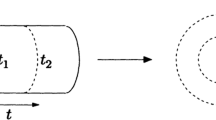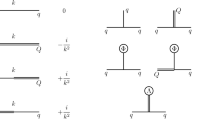Abstract
The emergence of a hierarchy of scales in the case of spontaneous radiative breaking of conformal symmetry is discussed using the example of a simple quantum-field-theory model. The Coleman–Weinberg (C–W) mechanism is implemented in the one-loop approximation of the effective potential of a scalar field interacting with a fermion field. The emergence of a hierarchy between the renormalization scale and the magnitude of the scalar-field vacuum expectation value is shown. An effective model in the vicinity of the effective potential minimum is constructed and the absence of a direct renormalization group transition to the original theory is established. It is shown that measuring the effective model parameters in the infrared region allows us to determine the scale that limits the applicability region of the model.
Similar content being viewed by others
Notes
When defining the concept effective theory, we follow the work [3].
Strictly speaking, we will consider the violation of scale invariance, but in this case, the violation of conformal invariance also occurs [8].
The gauge interactions available in the SM are easy to include in the consideration, but this will not affect the main fundamental points discussed below.
A study is being prepared with appropriate analysis.
REFERENCES
J. A. Casas, J. R. Espinosa, and I. Hidalgo, “Expectations for LHC from naturalness: Modified versus SM Higgs sector,” Nucl. Phys. B 777, 226–252 (2007); arXiv: hep-ph/0607279.
G. F. Giudice, “Naturally speaking: The naturalness criterion and physics at the LHC,” in Perspectives on LHC Physics, Ed. by G. Kane (World Scientific, Singapore, 2008); arXiv:hep-ph/0801.2562.
S. Rivat, “Renormalization scrutinized,” Stud. Hist. Phil. Sci. B 68, 23–39 (2019).
F. Englert and R. Brout, “Broken symmetry and the mass of Gauge vector mesons,” Phys. Rev. Lett. 13, 321–323 (1964).
P. W. Higgs, “Broken symmetries and the masses of Gauge bosons,” Phys. Rev. Lett. 13, 508–509 (1964).
V. L. Ginzburg and L. D. Landau, “To the theory of superconductivity,” Zh. Eksp. Teor. Fiz. 20, 1064 (1950).
W. A. Bardeen, “On naturalness in the standard model,” FERMILAB-CONF-95-391-T (1995).
Y. Nakayama, “Scale invariance vs conformal invariance,” Phys. Rep. 569, 1–93 (2015); arXiv:1302.0884 [hep-th].
S. R. Coleman and E. J. Weinberg, “Radiative corrections as the origin of spontaneous symmetry breaking,” Phys. Rev. D: Part. Fields 7, 1888–1910 (1973).
Ch. T. Hill, “Conjecture on the physical implications of the scale anomaly,” FERMILAB-CONF-05-482-T (2005); arXiv:0510177 [hep-th].
A. B. Arbuzov, V. N. Pervushin, R. G. Nazmitdinov, A. E. Pavlov, and A. F. Zakharov, “Spontaneous radiatively induced breaking of conformal invariance in the standard model,” in Proceedings of the 18th International Seminar on High Energy Physics, 2014; arXiv: 1411.5124 [hep-th].
A. Arbuzov and D. Cirilo-Lombardo, “Radiatively induced breaking of conformal symmetry in a superpotential,” Phys. Lett. B 7598, 125 (2016); arXiv: 1509.08907 [hep-th].
V. A. Miransky, Dynamical Symmetry Breaking in Quantum Field Theories (World Scientific, Singapore, 1993).
M. B. Voloshin and K. A. Ter-Martirosyan, The Theory of Gauge Interactions of Elementary Particles (Energoatomizdat, Moscow, 1984).
S. Jian, M. M. Scherer, and H. Yao, “Mass hierarchy in collective modes of pair-density-wave superconductors,” Phys. Rev. Res. 2, 013034 (2020); arXiv: 1810.01415 [cond-mat.str-el].
ACKNOWLEDGMENTS
We are grateful for fruitful discussions and critical comments of I.V. Anikin and B.N. Latosh.
Author information
Authors and Affiliations
Corresponding author
Rights and permissions
About this article
Cite this article
Arbuzov, A.B., Voznaya, U.E. & Kopylova, T.V. On the Hierarchy of Scales in Radiative Symmetry Breaking. Phys. Part. Nuclei Lett. 18, 123–127 (2021). https://doi.org/10.1134/S1547477121020047
Received:
Revised:
Accepted:
Published:
Issue Date:
DOI: https://doi.org/10.1134/S1547477121020047




